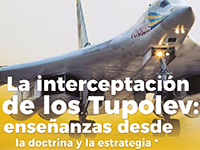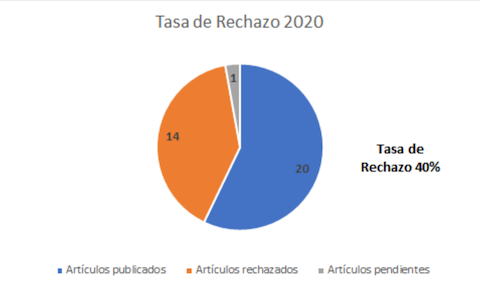The Tupolev Interception: Lesson from doctrine and strategy
DOI:
https://doi.org/10.18667/cienciaypoderaereo.635Keywords:
Asymmetrical Disadvantage, Military Capabilities, Strategy, TupolevAbstract
On November 1, 2013, two Russian Tupolev airplanes, including the world’s fastest nuclear bomber, entered Colombia’s national air space with no previous authorization. The interception process and the decisions made on a strategic level have left us, following Colin S. Gray’s theory, with some issues to reflect upon and some lessons that we must learn for Colombia to evolve in its decision-making process, and also for us to remember the importance of strategy in the use of air power. Specifically, the lessons derived from this experience allow Colombia to reflect on how to approach a situation of asymmetrical disadvantage when facing its enemies. It also forces us to recognize that military decisions are not the only deciding factors of strategy; instead, political will, the nation’s commitment and awareness of the country’s defense also have a role to play.
Downloads
References
Barry R. Posen (2003). Command of the Commons: The Military Foundation of US Hegemony, International Security, Vol. 28, No. 1 (Summer 2003), pp. 5-46. https://doi.org/10.1162/016228803322427965
Boyne, W. J. (2002). Air Warfare: An International Encyclopedia, Abc-clio.
Bukharin, O. (2004). Russian strategic nuclear forces, MIT Press.
Buzan, B. (1996). The timeless wisdom of realism. International theory: positivism and beyond, 47-65. https://doi.org/10.1017/CBO9780511660054.004
Buzan, B., & Hansen, L. (2009). The Evolution of International Security Studies. Political Science. https://doi.org/10.1017/CBO9780511817762
Buzan, B., Wæver, O., Wæver, O., & De Wilde, J. (1998). Security: a new framework for analysis. Lynne Rienner Publishers.
Camargo, P. P. (1984). La Convención sobre el derecho del mar: (texto y comentarios). Editorial Temis Librería.
Castro, C. A. A. and C. A. P. Herrera (2014). Reflexiones sobre la guerra de cuarta generación, una visión desde los actores sin recursos de poder en términos tradicionales. Ciencia y Poder Aéreo 9 (1): 79-87. https://doi.org/10.18667/cienciaypoderaereo.136
Chairman Mao,"The Chinese People Cannot be Cowed by the Atom Bomb," and"S.Imperialism is a Paper Tiger," in Selected Works of Mao Tse-tung, vol. 5, 152-53, 308-311
CNN. (2013). Colombia denuncia que dos bombarderos rusos violaron su espacio aéreo.
Council, N. R. D. (2006). Russian nuclear forces, 2006. Bulletin of the Atomic Scientists, 62 (2), 64-67. https://doi.org/10.1080/00963402.2006.11460975
Creveld, M. van. (1991). The transformation of war. New York: Free Press.
Douhet, G. (2009). The command of the air. University of Alabama Press.
Ehrlich, H. J., & Note, A. P. (1996). Anarchism and formal organization. Reinventing anarchy, again, 56-68.
Gladwell, M. (2013). David and Goliath: Underdogs, misfits, and the art of battling giants. Hachette UK.
Gray, C. S. (2012). The Airpower Advantage in Future Warfare: The Need for Strategy, Lulu. com.
Gray, C. S. (2015). Strategic Studies and Public Policy: The American Experience. University Press of Kentucky.
Hollis, M. (1990). Explaining and understanding international relations.
Holsti, K. J., & Holsti, K. J. (1996). The state, war, and the state of war (No. 51). Cambridge University Press. https://doi.org/10.1017/CBO9780511628306
Jeremi S. (2003). Power and Protest: Global Revolution and the Rise of Détente. Cambridge, Massachusetts: Harvard University Press, pp. 1-87
Jervis, R. (1986). Cognition and political behavior. Political cognition, 319-336.
Kennan, G. F. (1947). Memoirs, 1925-1950. Boston, 1967. For the Press. May, 7, 1.
Kenneth, W. (1959). Man, the State and War. A theoretical analysis. New York: Columbia University Press.
Lieber, K. A., & Press, D. G. (2006). The end of MAD? The nuclear dimension of US primacy. International Security, 30(4), 7-44. https://doi.org/10.1162/isec.2006.30.4.7
Lüthi, L. (2008). The Vietnam War and China's Third-Line Defense Planning before the Cultural Revolution, 1964-1966. Journal of Cold War Studies, 10(1), 26-51. https://doi.org/10.1162/jcws.2008.10.1.26
Morgenthau, H. (1948). 1978. Politics among nations: The struggle for power and peace. New York: Alfred S. Knopf.
Nye Jr, J. S., & Lynn-Jones, S. M. (1988). International security studies: a report of a conference on the state of the field. International Security, 12(4), 5-27. https://doi.org/10.2307/2538992
Riquelme-Cortado, R. M. (1985). Reflexiones sobre la firma y la ratificación de la Convención de las Naciones Unidas sobre el Derecho del Mar (1982). A propósito de la firma por España.
Shang, C. (2011). Dancing with his "Lesser Evil"-Mao's China from 1962-68 and the road to rapprochement with the United States. University of Arkansas.
Skinner, Q. (1978). The Foundations of Modern Political Thought. The Age of Reformation (Vol. 2). Cambridge University Press.
Smoke, R. (1975). National Security Affairs. Hand- book of Political Science, 8, 247-362.
Terriff, T., Croft, S., James, L., & Morgan, P. (2000). Security studies today. Polity.
Trest, W. A. (1998). Air Force Roles and Missions: A History. Government Printing Office. https://doi.org/10.21236/ADA476260
Tse-Tung, M. (2014). Selected works of Mao Tse-tung (Vol. 5). Elsevier.
Waltz, K. N. (1988). The origins of war in neorealist theory. The Journal of Interdisciplinary History 18(4): 615-628. https://doi.org/10.2307/204817
Waltz, K. (1979). Theory of international politics: reading. University of California, Berkeley: Addison-Wesley Publishing Company, In.
Wohlforth, W. C. (1993). The elusive balance: power and perceptions during the Cold War. Cornell University Press.
Wolfers, A. (1952). "National security" as an ambiguous symbol. Political Science Quarterly, 67(4), 481-502 https://doi.org/10.2307/2145138

Downloads
Published
Issue
Section
License
Copyright (c) 2021 Escuela de Postgrados de la Fuerza Aérea Colombiana

This work is licensed under a Creative Commons Attribution 4.0 International License.
Assignment of Copyrights
Authors assign Ciencia y Poder Aéreo journal the exclusive rights (reproduction, distribution, public communication, and transformation) to exploit and commercialize their work, in whole or in part, in all the formats and modalities of present or future exploitation, in all languages, throughout the life of the work and throughout the world.
All contents published in Ciencia y Poder Aéreo journal are licensed under a Creative Commons Attribution 4.0 International License, whose complete information is available at http://creativecommons.org/licenses/by/4.0/
Under the terms of this license, users are free to download, print, extract, archive, distribute and publicly communicate the content of articles, provided that proper credit is granted to authors and Ciencia y Poder Aéreo, scientific journal of the Graduate School of the Colombian Air Force. Except when otherwise indicated, this site and its contents are licensed under a Creative Commons Attribution 4.0 International License.
For other uses not considered under this license it is required to contact the Director or the Editor of the journal at the e-mail address cienciaypoderaereo1@gmail.com.
The Graduate School of the Colombian Air Force and this publication are not responsible for the concepts expressed in the articles, including the metadata or the affiliation stated by authors. This is the full responsibility of the authors.





















